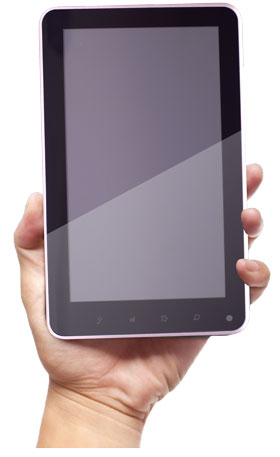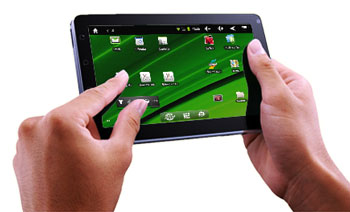 Pitched as an “SA-inspired” tablet, the first generation of Wise Touch Tablets are meant as a budget alternative to high-end tablets. The tablets offer preinstalled localised content and are intended for educational applications. The biggest selling point of the Wise tablet is its price. At R2 100 for the Wi-Fi-only model, it’s one of the cheapest options in SA today.
Pitched as an “SA-inspired” tablet, the first generation of Wise Touch Tablets are meant as a budget alternative to high-end tablets. The tablets offer preinstalled localised content and are intended for educational applications. The biggest selling point of the Wise tablet is its price. At R2 100 for the Wi-Fi-only model, it’s one of the cheapest options in SA today.
From a hardware perspective, it’s little surprise that the Wise is fairly run-of-the-mill. That’s not to say it’s bad — it isn’t. Running Android 2.3, the 7-inch tablet is powered by a 1GHz Rockchip 2918 processor and 512MB of RAM, which makes it a surprisingly speedy device.
The screen is a capacitive multi-touch, 800×480-pixel display and it’s unusually responsive – so responsive, in fact, that it sometimes registers the briefest touch and takes a little getting used to. The resolution might not be the highest for a 7-incher, but that’s in keeping with the price point.
Like most budget tablets, the Wise tablet includes only 4GB of flash memory but, like the bulk of its peers, it also offers expansion up to 32GB via a microSD slot on the rear. Due to the large number of applications preinstalled, users have access to only about 2GB of the onboard storage. However, this can be increased with a little pruning of the applications folder contents.
The team behind the Wise tablet has really gone to town when it comes to installing apps on the device. Although setting the local time and installing some of the most popular Android apps is a good move, installing dozens of applications and creating shortcuts to a slew of SA websites is less inspired.
By way of example, just the A through C section of the apps menu includes shortcuts to the websites of 1Time, Absa, Auto Trader, AutoMart, BidorBuy, Business Park (a Wise application that duplicates many of these), Capitec Bank, Checkers, Computicket and Cum Books. This is less useful than it is annoying.
Kalahari has six separate shortcuts in the app menu alone. PriceCheck has four, including the general site and shortcuts to its books, music and travel pages.
Aside from the Business Park app, the tablet also includes two other Wise-branded portals, the Wise Education Centre and the Wise Shopping Mall. Like the Business Park portal, Shopping Mall feels like it’s simply a means of punting SA brands. This may have helped bring down the cost of the device but one wonders how much use the average user will actually make of either.
The Wise Education Centre, meanwhile, offers a small selection of educational videos and PDFs of the public school syllabus for all major subjects. There’s also a selection of interactive educational games but these are very basic. If the offers are substantially expanded this could be one of the best selling points of the device, although its poor screen resolution means it’s not ideally suited for protracted reading sessions.
Though the unit we received for review doesn’t offer 3G connectivity, there is another model that does, and while it only costs R400 more, it offers a smaller battery — 3 000mAh compared to 4 000mAh — which makes it seem like a poorer deal, even with a higher screen resolution of 800×600 pixels.
The Wi-Fi-only model takes about three-and-a-half hours for a full charge and then lasts about four hours in normal use with Wi-Fi activated. This figure drops further if the device is used to consume video or audio.
 There’s no automatic brightness option in the display menu, but again these sorts of omissions are to be expected when a device can offer such a modest price. Other notable omissions are GPS and Bluetooth.
There’s no automatic brightness option in the display menu, but again these sorts of omissions are to be expected when a device can offer such a modest price. Other notable omissions are GPS and Bluetooth.
Sensibly, the tablet includes only a single, 2-megapixel front-facing camera, which is ideal for video chat or shoddy self-portraits — arguably the only things a tablet camera should really be used for.
Like almost all Android tablets, the Wise has a proprietary charger. However, unlike other tablets it uses mini USB rather than rather than micro USB. There’s also a mini HDMI-out port and a 3,5mm headphone jack.
The front of the tablet has a power/lock button and a volume rocker on the top right edge when held in landscape orientation and otherwise the only buttons are capacitive ones to the right of the screen. These are the standard Android offerings of search, home, menu/options and back.
Compared to many budget tablets on the market, the Wise feels pleasingly sturdy and the finish is equally pleasant. The volume and power buttons are responsive, and the faux metal trim around the screen and rubberised rear panel belie its budget price tag.
The tablet’s treatment of Android is understated and includes a couple of pleasant but confusing touches, most notably the volume, back and menu buttons in the display bar. They’re good to have, but they also render the buttons alongside the display somewhat redundant.
There is, however, one aspect of the Wise tablet that cripples it to some extent. It doesn’t offer the Google Play store, which means apps can’t be updated or replaced should you delete something and wish to restore it. The Wise Support Forum is no use in this regard, either, as there haven’t been any posts since last December.
It turns out the absence of the Play store is due to the device not being registered with Google. Wise says it’s working to rectify this for the second generation it plans to launch later this year.
Ultimately, the Wise tablet is a step in the right direction if the destination is getting budget tablets into the hands of more people in SA. But without an official Google tie-in or access to additional apps, it seems those most likely to buy it are consumers looking for a cheap tablet they can hack, which can’t be what its designers had in mind.
With any luck, the second generation will make up for the deficiencies of the first. It’s a noble project, but it still needs a lick of polish. — (c) 2012 NewsCentral Media




